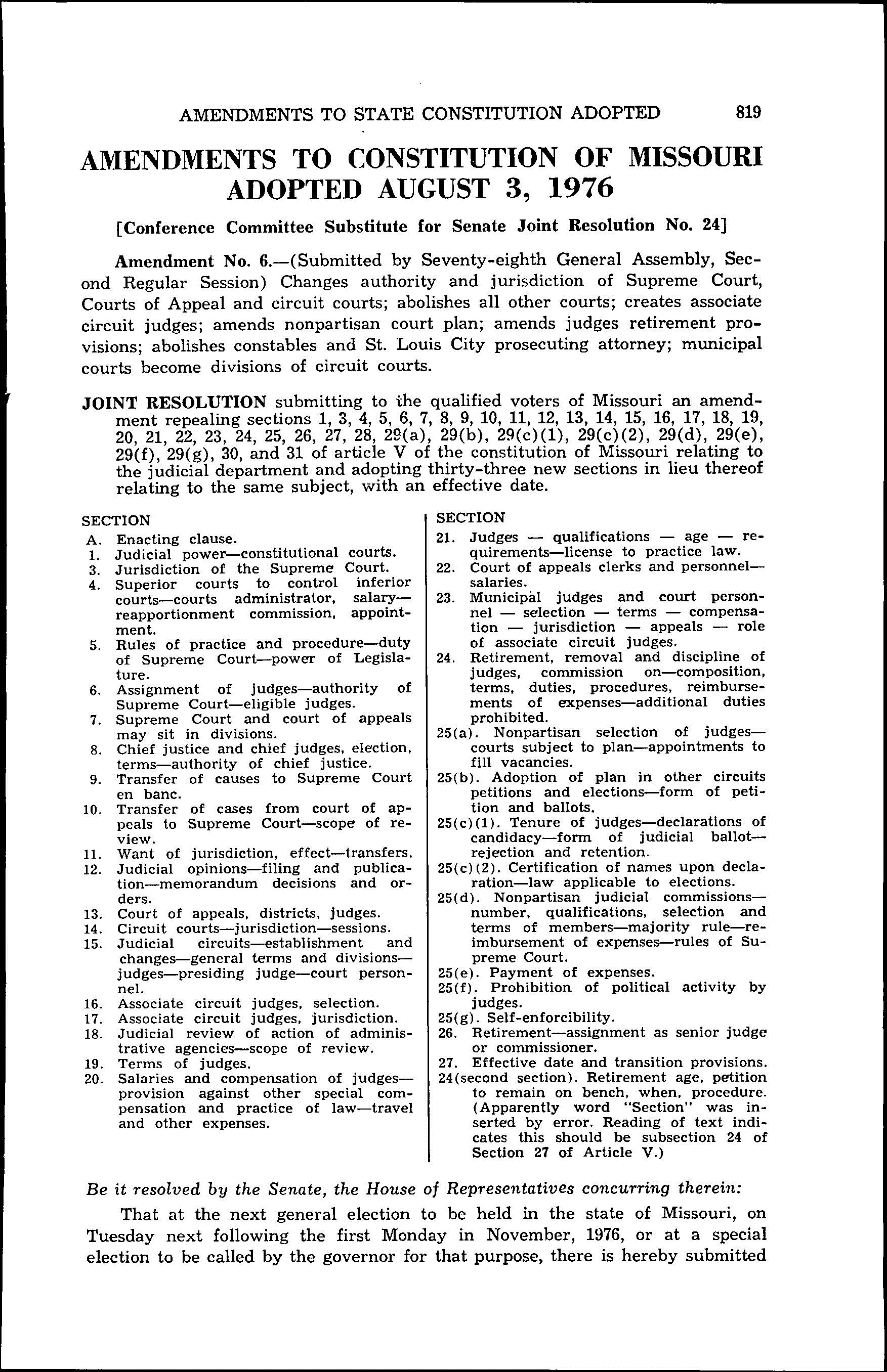Through much of Missouri's history, local courts – including magistrate, probate and circuit courts – operated as largely independent, without much collaboration or coordination.
In the 1970s, however, as greater focus was placed on improving the administration of the nation's courts, efforts were undertaken to study Missouri's courts to determine how they might be made more efficient and more effective. The result was a proposal to overhaul the judicial branch completely, rewriting the state constitution's article V, which governed the courts. Great care, however, was taken to minimize disruption the changes might have on local lawyers and litigants.
 Ultimately, a legislative referendum was put before voters during the August 1976 election as Amendment 6. Titled the "1978 Court Revision & Reform Act," the amendment proposed, in part, to:
Ultimately, a legislative referendum was put before voters during the August 1976 election as Amendment 6. Titled the "1978 Court Revision & Reform Act," the amendment proposed, in part, to: Change the authority and jurisdiction of the Supreme Court of Missouri, the ;appellate courts and circuit courts;
Make municipal courts divisions of circuit courts
Abolish all other courts;
Amend judges' retirement provisions.
Amend the nonpartisan court plan; and
Create associate circuit judges;
As described, all judges elected in 1978 would take office January 1, 1979. The next day, all magistrate courts, probate courts, courts of common please, the St. Louis court of criminal correction and municipal courts would cease to exist, with the jurisdictions of those courts transferring to the circuit court and such courts becoming divisions of the circuit court.
Judges of the St. Louis court of criminal correction, all courts of common pleas and the probate courts in first- or second-class counties with populations of more than 65,000 would become circuit judges. All other probate judges and all magistrate judges would become associate circuit judges. The amendment allowed municipalities to elect to provide their own municipal judges or to have municipal cases heard by associate circuit judges.
As to the intermediate appellate courts, the amendment consolidated the three separate courts – the St. Louis Court of Appeals, the Kansas City Court of Appeals and the Springfield Court of Appeals – into a single Missouri Court of Appeals with three geographic districts. The Eastern District retained the territorial jurisdiction of the St. Louis Court of Appeals; the Western District assumed the territorial jurisdiction of the Kansas City Court of Appeals; and the Southern District continued the territorial jurisdiction of the Springfield Court of Appeals.
Consolidation also moved the automatic right to appeal in certain cases from the Supreme Court of Missouri to the Missouri Court of Appeals. Given the shift in cases, the amendment also eliminated the positions of commissioners of the Supreme Court upon the resignation, retirement, death or removal for cause of all existing commissioners. It allowed the Court to sit "en banc," with all seven judges, instead of in divisions of just three or four judges.
On August 3, 1976, voters statewide passed Amendment 6, and the new provisions of article V became effective in January 1979 as scheduled.
The resulting consolidation brought the various elements of the modern judiciary into a single, coordinated system, paving the way for enhanced efficiency and service to the public. For example, no matter a judge's "home" court, all judges are considered judges of the state of Missouri, and so any judge from any court can be "transferred" to hear cases anywhere in the state, at any level of court.
The constitution now requires judges to retire from active service at age 70 – or they risk losing their entire pensions. A new “senior judge” program established as part of this revision and reform act allows citizens to benefit from the experience of judges who wish to continue providing limited service – often to help cover a local court’s overload of cases or fill in when a judge has recused from a particular case.
The only judge to have served at every level of the judiciary, John C. Holstein, served as a jurist from 1975 to 2002. In 1975, he was appointed a probate and magistrate judge and, in 1976 and 1978, was elected probate judge – a position that became an associate circuit judge in January 1979. In 1982, he was elected circuit judge of the 37th Judicial Circuit (Carter, Howell, Oregon and Shannon counties), for which he also served as presiding judge. In 1987, then-Governor John Ashcroft appointed Holstein to the Missouri Court of Appeals, Southern District, where Holstein served as chief judge from 1988 to 1989. In 1989, Ashcroft appointed Holstein to the Supreme Court of Missouri. He served as Missouri's chief justice from July 1995 through June 1997. He retired March 1, 2002, returning to private practice and later to provide mediation and other alternative dispute resolution services in Springfield.
As of July 2020, the last two active judges who served as magistrates before becoming associate circuit judges under the revision of article V (and later appellate judges) remained on the bench: Judge Roy L. Richter of Montgomery County, and Judge Robert G. Dowd Jr. of St. Louis, both judges on the Missouri Court of Appeals, Eastern District. With their 70th birthdays looming, both since retired: Richter on July 13, 2020, and Dowd on December 31, 2020.